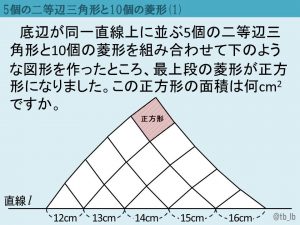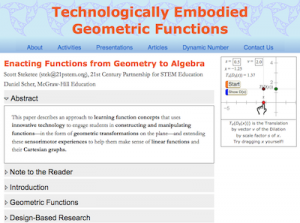At the 2017 NCTM Annual Meeting I was invited to do a short Wednesday-afternoon presentation on Function Dances in the NCTM Networking Lounge. (Here's the handout from the presentation.) The idea of function dances is to get students (or in this case teachers) moving around, acting as the independent and dependent … Continue Reading ››
Revisiting the Isosceles Triangle Challenge
In my last post, I presented a lovely geometry problem from Japan that was ideally suited to a dynamic geometry approach. Below is a new problem whose construction is nearly identical to the original one. The text says, "Five isosceles triangles have their bases on one line, and there are 10 rhombi. One length of the rhombus … Continue Reading ››
A Geometry Challenge from Japan
Here is a wonderful geometry problem from Japan: The five triangles below are all isosceles. The quadrilaterals are all rhombi. The shaded quadrilateral is a square. What is the area of the square?  I wondered at first whether the English translation of the problem was correct because with so many side … Continue Reading ››
I wondered at first whether the English translation of the problem was correct because with so many side … Continue Reading ››
 I wondered at first whether the English translation of the problem was correct because with so many side … Continue Reading ››
I wondered at first whether the English translation of the problem was correct because with so many side … Continue Reading ››The Varied Paths to Constructing a Square
Using dynamic geometry software, students can use a Segment tool to draw what looks like a square by eyeballing the locations of the vertices. However, the resulting quadrilateral will not stay a square when its vertices are dragged. Building an “UnMessUpAble” square requires that the quadrilateral stay a square when any of its parts are … Continue Reading ››
Make Your Own Fractions
In my very first Sine of the Times blog post from January 2012, I wrote about the paucity of fractions that young learners typically encounter in their math classes. While they might construct visual representations of 1/2, 2/3, and 8/12, it's unlikely they'll create models of 7/31, 36/19, or 5/101. That's a shame because without … Continue Reading ››
Stars, Polygons, and Multiples
I've always found my collaborations with teachers to be a great inspiration for curriculum development, and that was especially true of my work with Wendy Lovetro, an elementary-school teacher in Brooklyn, NY. Wendy coordinated an after-school math club at her school, and I used the setting as an opportunity to develop and field test Sketchpad activities for the … Continue Reading ››
Raz’s Magic Multiplying Machine
Here is a question you don't hear very often: What does it feel like to experience multiplication in our bodies? It's a strange question because our typical exposure to multiplication is numerical. I give you two numbers—say, 3 and 5—and you tell me their product, 15. But multiplication need need not be so static and concrete. Back … Continue Reading ››
Pythagoras Plugged In
The title of this post is a nod to the Sketchpad activity module Pythagoras Plugged In by Dan Bennett. Dan's book contains 18 visual, interactive proofs of the Pythagorean Theorem. And there are more: The Pythagorean Proposition, published in 1928 by Elisha Scott Loomis, contains over 350 proofs, 255 of which are geometric. Wow! I revisited the … Continue Reading ››
International Congress for Mathematics Education Part 2
I began this post on Friday night in Hamburg Germany, near the end of ICME, the quadrennial international math-education conference that's been both exhilarating and exhausting. I’m now finishing it on the airplane headed back home.  As interesting as many of the presentations have been, they've also been … Continue Reading ››
As interesting as many of the presentations have been, they've also been … Continue Reading ››
 As interesting as many of the presentations have been, they've also been … Continue Reading ››
As interesting as many of the presentations have been, they've also been … Continue Reading ››Decomposing Number Challenges
The mental arithmetic game 'Make 20' begins with students sitting in a circle. The teacher picks a student to call out a random number between 0 and 20. Students raise their hands, and whoever is chosen by the teacher must say what number, when added to the first, makes 20. The game continues in this manner, with students picking random … Continue Reading ››